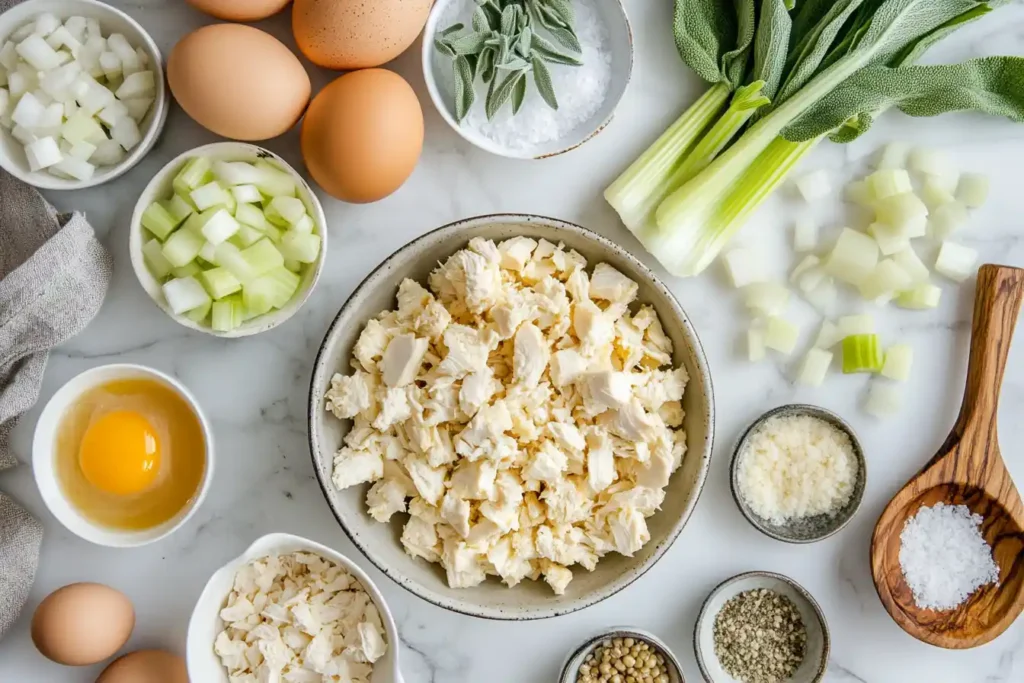Introduction to Chicken Dressing
What Is Chicken Dressing?
Chicken dressing is a savory dish, often a holiday favorite in Southern cooking, made by blending crumbled bread (commonly cornbread), shredded chicken, and a mix of herbs and vegetables. Baked until golden, its texture is moist yet firm, making it the perfect accompaniment to meals like roast chicken or turkey. But, oh, it’s not just about the ingredients! The preparation transforms humble staples into a dish that speaks of home, comfort, and tradition.
Historical Origins of Chicken Dressing
The origins of chicken dressing date back centuries. It evolved from stuffing, a practice brought by European settlers to America, which involved filling poultry with a mixture of bread and spices. Over time, Southern cooks began baking this mixture separately, calling it “dressing” instead of “stuffing.” This adaptation became a cultural hallmark, particularly in Southern households, where cornbread emerged as the bread of choice. It reflects resourcefulness and a love for richly seasoned, soul-satisfying dishes.
Difference Between Dressing and Stuffing
While the terms are often used interchangeably, the distinction lies in preparation. Dressing is cooked separately in a casserole dish, while stuffing is prepared inside the bird. The choice often comes down to regional preferences: Southerners love dressing, while Northerners often opt for stuffing. Importantly, cooking dressing outside the bird ensures a crisp, flavorful crust while keeping the dish moist and evenly cooked.
Ingredients and Preparation
Key Ingredients in Chicken Dressing

Creating the perfect chicken dressing starts with a careful selection of ingredients. These components not only determine the flavor but also influence the dish’s texture and moisture. Let’s break it down:
- Bread Base: The foundation of chicken dressing is crumbled cornbread or cubed white bread. Cornbread gives a Southern flair, while white bread offers a neutral canvas for seasonings. Learn how to make the perfect cornbread recipe.
- Protein: Shredded, cooked chicken brings a hearty, savory element. Dark or white meat can be used based on preference.
- Aromatics: Chopped onions, celery, and minced garlic add a fragrant base, infusing every bite with rich flavor.
- Herbs and Spices: Traditional choices include sage, thyme, rosemary, salt, and pepper, creating the dish’s signature aroma.
- Liquids: Chicken broth and beaten eggs bind the ingredients together while ensuring moisture during baking.
- Fats: Butter or oil is essential for sautéing aromatics and adds richness to the dressing.
Step-by-Step Preparation Guide
Making chicken dressing may seem daunting, but it’s a straightforward process when broken into manageable steps. Follow these to ensure your dish turns out delicious every time.
- Prepare the Bread
Start by baking cornbread or using day-old bread. Crumble or cube it to create a base with texture. Let it sit uncovered for a few hours to dry slightly, enhancing its ability to absorb liquid. - Cook the Chicken
Boil or roast the chicken, then shred it into bite-sized pieces. This step can be done ahead of time for convenience. - Sauté Aromatics
Heat butter or oil in a skillet over medium heat. Sauté chopped onions, celery, and minced garlic until they become soft and translucent, releasing their natural sweetness. - Combine Ingredients
In a large mixing bowl, combine the bread, shredded chicken, sautéed aromatics, and herbs. Stir gently to ensure the mixture is evenly distributed. - Add Liquids
Gradually pour in beaten eggs and chicken broth, mixing until the bread is moist but not overly soggy. The consistency should be slightly firm but pliable. - Bake
Transfer the mixture to a greased baking dish, spreading it evenly. Bake in a preheated oven at 350°F (175°C) for about 45 minutes, or until the top turns golden brown and slightly crisp.
Common Variations of Chicken Dressing
Chicken dressing is versatile, and small tweaks can create exciting new flavors:
- Seafood Addition: Add oysters or shrimp for a coastal twist, blending seafood sweetness with the savory base.
- Sausage Mix: Stir in crumbled, cooked sausage for a smoky, hearty profile.
- Vegetarian Option: Replace chicken with sautéed mushrooms or tofu for a plant-based alternative.
- Gluten-Free: Substitute traditional bread with gluten-free options like cornbread made from gluten-free flour.
These variations cater to dietary preferences and regional tastes, making chicken dressing a dish for everyone!
Serving and Pairing Suggestions
Traditional Occasions for Serving Chicken Dressing

Chicken dressing holds a special place in Southern traditions, making it a centerpiece during Thanksgiving, Christmas, and other cherished family gatherings. Its comforting texture and savory flavor are synonymous with warmth and celebration. Thanksgiving tables, in particular, wouldn’t feel complete without a golden dish of chicken dressing alongside turkey and gravy.
Moreover, chicken dressing often symbolizes more than just food; it’s a way to honor family recipes passed down through generations. At Christmas, it pairs beautifully with roasted meats or a comforting cream of turkey soup recipe. while during smaller family reunions, it shines as a standalone star, evoking nostalgia and togetherness.
Side Dishes That Complement Chicken Dressing
The beauty of chicken dressing lies in its versatility, making it an excellent companion to various side dishes that enhance its flavors:
- Cranberry Sauce: The tangy, sweet-tart flavor of cranberry sauce cuts through the savory richness of chicken dressing, adding a vibrant contrast.
- Green Beans: Lightly sautéed or steamed green beans provide a crisp, fresh texture that balances the dish’s hearty nature.
- Mashed Potatoes: Creamy and buttery, mashed potatoes are a natural match, creating a rich, indulgent plate.
- Gravy: A drizzle of savory gravy not only amplifies the flavor but also ensures every bite remains moist and satisfying.
Pair these sides with chicken dressing for a meal that’s nothing short of unforgettable!
Non-Alcoholic Beverage Pairings for Chicken Dressing Meals
When it comes to beverages, there are plenty of refreshing options to complement chicken dressing without overpowering its savory depth:
- Sparkling Apple Cider: Lightly sweet with a subtle fizz, it’s festive and pairs well with the dish’s earthy notes.
- Sweet Tea: A Southern classic, sweet tea’s mellow sweetness complements the rich flavors of chicken dressing, making it a perfect match for holiday meals.
No matter the occasion, serving chicken dressing with the right sides and drinks elevates it into an unforgettable dining experience.
Nutritional Information and Dietary Considerations
Analyzing the Nutritional Value of Chicken Dressing
A Detailed Look at Chicken Dressing Nutrition (Per 100g)
| Nutrient | Amount |
|---|---|
| Calories | 250 kcal |
| Protein | 10 g |
| Carbohydrates | 27 g |
| Fat | 12 g |
| Sodium | 580 mg |
| Fiber | 2 g |
| Cholesterol | 50 mg |
| Calcium | 45 mg |
| Iron | 1.5 mg |
Chicken dressing is undeniably a flavorful addition to any meal, but understanding its nutritional profile helps balance indulgence with informed choices. On average, a serving (about 1 cup) of traditional chicken dressing contains:
- Calories: Approximately 250–300 calories, depending on the ingredients and portion size.
- Protein: Around 10–15 grams, largely contributed by shredded chicken.
- Carbohydrates: About 25–30 grams, primarily from bread or cornbread.
- Fat: Roughly 10–15 grams, depending on the amount of butter or oil used.
- Sodium: Can range between 500–700 milligrams, heavily influenced by broth and seasoning choices.
In addition to macronutrients, chicken dressing provides essential vitamins like B-complex (from the bread) and minerals like potassium and phosphorus (from chicken and vegetables). However,Its sodium and fat content can be high, making portion control important. Learn how many days chicken dressing stays fresh. For those aiming to reduce calories or sodium, slight ingredient modifications can make a significant difference.
Modifying Chicken Dressing for Special Diets
Chicken dressing’s versatility makes it easy to adapt for a variety of dietary needs without sacrificing flavor or texture. Here’s how you can modify it for specific preferences:
- Low-Sodium: Use reduced-sodium chicken broth and unsalted butter to drastically cut down on sodium levels. Additionally, fresh herbs like sage and thyme can replace salt for seasoning.
- Low-Fat: Opt for lean chicken breast and minimize the use of butter or oil during preparation. Replacing some of the butter with a low-fat cooking spray can also reduce the overall fat content.
- Vegetarian/Vegan: Skip the chicken entirely and substitute with hearty vegetables like mushrooms or plant-based protein alternatives. Use vegetable broth instead of chicken broth, and swap eggs for flaxseed meal or other vegan binders to maintain structure.
These tweaks not only make chicken dressing accessible to a broader audience but also ensure it remains a delicious and satisfying part of any meal.
Frequently Asked Questions About Dressing of Chicken
Dressing is baked separately, often with cornbread, while stuffing is cooked inside the bird, absorbing its juices. Dressing is crispier and common in Southern cuisine.
Yes! Assemble it, cover tightly, and refrigerate for up to 24 hours. Bake directly from the fridge, adding 5–10 minutes. For freezing, cool, portion, and store for up to three months. Thaw overnight and reheat with a splash of broth for moisture.
Absolutely. Cool the dressing, portion into airtight containers, and freeze for three months. Reheat at 350°F, covered with foil, adding broth for moisture.
Cornbread is traditional for its sweetness and crumbly texture. Alternatives like day-old white bread, sourdough, or ciabatta work well. Mixing cornbread with white bread creates a balanced, sturdy texture
Tips and Expert Advice
Pro Tips for Perfect Chicken Dressing
Creating the perfect chicken dressing doesn’t have to be intimidating! These expert tips can elevate your dish and ensure rave reviews every time:
- Use Day-Old Bread: Fresh bread can make dressing soggy. Slightly stale bread absorbs liquids better, resulting in a moist yet firm texture.
- Season Gradually: Taste your mixture before baking and adjust the seasoning as needed. The right balance of herbs, salt, and pepper is crucial.
- Don’t Overmix: Stir the ingredients gently to maintain the bread’s structure. Overmixing can lead to a dense, unappetizing texture.
- Add Broth Slowly: Gradually add broth to reach the desired consistency. The mixture should be moist but not overly wet.
- Rest Before Serving: Let the dressing sit for 10 minutes after baking. This allows flavors to meld and makes it easier to serve.
Common Mistakes to Avoid
Even seasoned cooks can stumble when making chicken dressing. Avoid these common pitfalls to ensure a flawless dish:
- Using Too Much Liquid: Overly wet dressing becomes mushy. Aim for a balance where the mixture holds together but isn’t soggy.
- Skimping on Aromatics: Onions, celery, and garlic are the backbone of flavor. Don’t be afraid to sauté them generously.
- Overbaking: Keep an eye on the oven! Overbaking can dry out your dressing, robbing it of its luscious texture.
- Skipping the Butter: Butter isn’t just for flavor—it also adds richness and moisture. A fat-free dressing can taste flat.
Creative Twists on Chicken Dressing
Traditional chicken dressing is fantastic, but experimenting with variations can breathe new life into this classic dish:
- Add Dried Fruits and Nuts: Mix in cranberries, raisins, or chopped pecans for a sweet and nutty contrast.
- Incorporate Cheese: Shredded sharp cheddar or grated parmesan adds a creamy, savory kick.
- Infuse International Flavors: Spice things up with curry powder, smoked paprika, or za’atar for a unique twist.
- Make Mini Dressings: Bake the mixture in muffin tins for individual servings, perfect for parties or potlucks.
Regional Variations and Unique Twists
Southern Style Chicken Dressing
Southern chicken dressing is the classic version most people envision when they think of this dish. Cornbread takes center stage, complemented by shredded chicken, onions, celery, and aromatic herbs like sage and thyme. The hallmark of Southern dressing is its bold, savory flavor and slightly crumbly texture. Often served during Thanksgiving or Christmas, it pairs beautifully with turkey, ham, or roasted vegetables.
Coastal Variations
In coastal regions, seafood takes the spotlight, transforming traditional dressing into something unique:
- Oyster Dressing: Oysters are added to the mixture, lending a briny, delicate flavor that complements the richness of the cornbread base.
- Shrimp Dressing: Small, tender shrimp are incorporated, offering a delightful seafood twist that’s popular in Gulf Coast cuisine.
These variations often include additional seasonings like Old Bay or cayenne for a spicy kick.
Midwestern and Northern Adaptations
In the Midwest and North, chicken dressing often leans toward white bread as the base instead of cornbread. The texture is softer, and additional ingredients like dried cranberries or apples may be added for a touch of sweetness. These versions also favor milder herbs like parsley and marjoram over the bold flavors of sage and thyme.
Vegetarian and Vegan Takes
For plant-based eaters, dressing can be just as satisfying with a few swaps:
- Replace chicken with hearty vegetables like mushrooms, sweet potatoes, or even chickpeas.
- Use vegetable broth instead of chicken broth.
- Vegan binders like chia seeds or flaxseed meal mixed with water can replace eggs.
This version preserves the rich flavors and comforting texture of traditional dressing while catering to dietary preferences.
Fusion-Inspired Creations
Innovative cooks have introduced international flavors to chicken dressing, creating exciting fusion dishes:
- Mexican-Inspired Dressing: Incorporates diced jalapeños, corn, and cotija cheese for a spicy, tangy twist.
- Mediterranean Style: Combines sun-dried tomatoes, olives, and feta cheese for a zesty, bold flavor.
- Asian Fusion: Features ingredients like ginger, soy sauce, and green onions for a completely fresh take on dressing.
Holiday-Specific Variations
Some cooks craft chicken dressing to reflect the season. For Thanksgiving, it might include roasted butternut squash and pecans, while Christmas variations often feature dried cherries or apricots for festive sweetness.
Chicken dressing’s adaptability and rich history make it a dish that continues to evolve, blending traditional methods with new, creative twists. Whether you stick to the classic Southern recipe or experiment with regional and international flavors, chicken dressing remains a beloved staple.
Conclusion: Celebrating the Art of Chicken Dressing
Chicken dressing is more than just a dish—it’s a cherished tradition rooted in Southern cooking. Versatile and adaptable, it shines at festive holidays, family dinners, or with creative modern twists. From its humble origins, it has become a flavorful classic, bringing people together across generations.
As you prepare your own version, each ingredient and step offers a chance to make it uniquely yours. Let chicken dressing be more than a recipe—let it become a beloved tradition in your kitchen.
Happy cooking, and may your chicken dressing always be golden and delicious!

